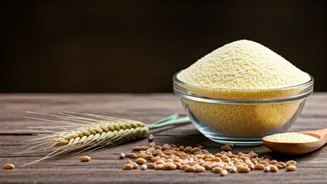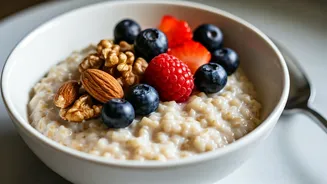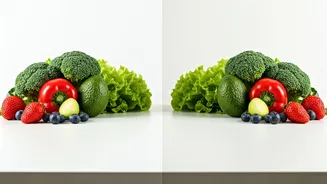Whole Wheat Benefits
Whole wheat provides a powerhouse of nutrition and contributes significantly to weight management. Unlike refined grains, whole wheat retains the entire
grain kernel—the bran, germ, and endosperm—offering a rich source of fiber. This fiber content is crucial for promoting satiety, keeping you feeling fuller for longer, which can naturally curb overeating and aid in calorie control. Furthermore, whole wheat is a good source of essential vitamins, minerals, and antioxidants, contributing to overall health and well-being. Regular consumption has been linked to various health benefits, including improved digestion, stable blood sugar levels, and reduced risk of chronic diseases. Opting for whole wheat over refined grains can be a sustainable strategy for supporting your weight loss goals while nourishing your body.
Sooji vs. Whole Wheat
When it comes to the sooji versus whole wheat debate for weight loss, the latter typically takes the lead due to its superior nutritional profile. Sooji, also known as semolina, is made from the endosperm of the wheat kernel, thus lacking the fiber and nutrients found in whole wheat. While sooji can be part of a balanced diet, it may not offer the same weight management benefits as whole wheat. Whole wheat contains more fiber, leading to better satiety and reduced calorie intake. It also provides a wider range of vitamins and minerals. The choice depends on individual dietary needs and preferences. However, for those focused on weight loss and enhanced nutrition, whole wheat is generally the better choice. It's important to consider that both can be included, but portion control and preparation methods matter.
Avoid Common Mistakes
To fully harness the weight-loss advantages of whole wheat, certain common mistakes should be avoided. One key error is assuming that all whole wheat products are created equal. Many packaged goods labeled as 'whole wheat' contain refined flours, added sugars, and unhealthy fats. Reading labels carefully and opting for products that list 'whole wheat' or 'whole wheat flour' as the first ingredient is crucial. Another common misstep is consuming excessive portions of whole wheat products, such as pasta and bread. While they are healthier choices than refined alternatives, portion control is still necessary to maintain a calorie deficit. Moreover, pairing whole wheat with high-calorie toppings or sauces can negate its benefits. Opt for healthy pairings like vegetables, lean proteins, and low-fat options to maximize the weight-loss potential.
Incorporate Whole Wheat
Integrating whole wheat into your diet is simple and can be done through various delicious and easy methods. Start by swapping refined white bread, pasta, and rice with their whole wheat counterparts. Look for whole wheat flour when baking at home, experimenting with recipes like whole wheat pancakes or muffins. Another effective method is adding whole wheat to your breakfast routine by consuming oatmeal or whole wheat cereal. Explore diverse whole wheat recipes, like salads or wraps using whole wheat tortillas. When eating out, choose whole wheat options whenever available. Experiment with various ways to enjoy whole wheat and find what works best for your taste and lifestyle. Consistent incorporation helps you experience its health and weight loss benefits over time.











